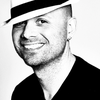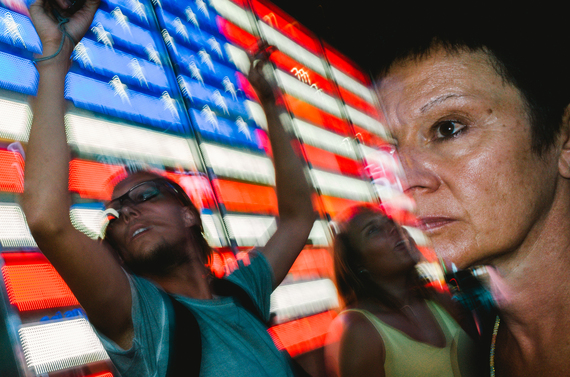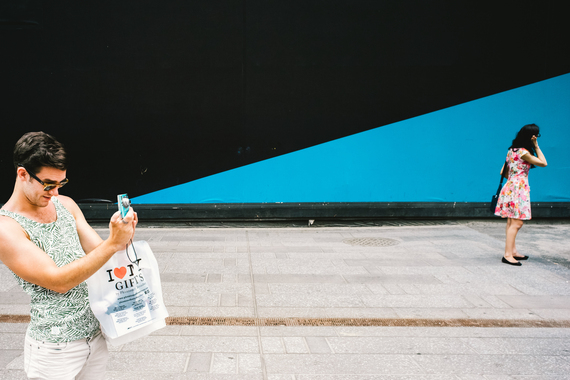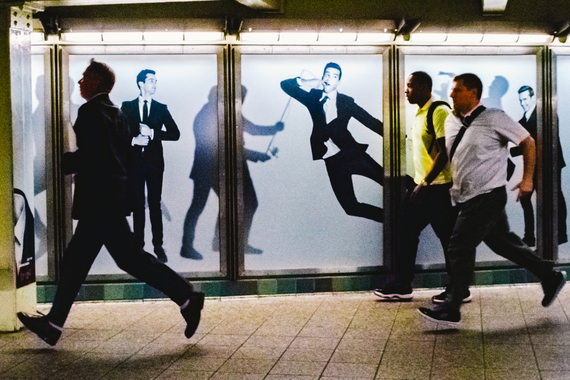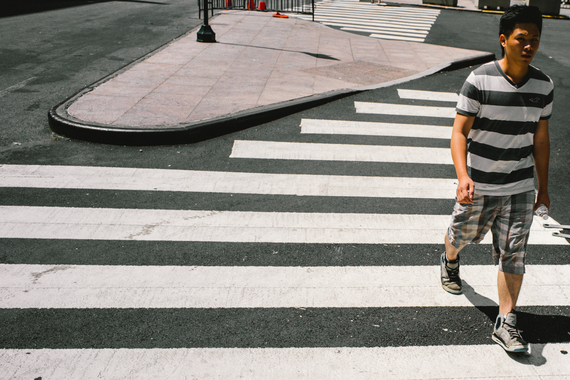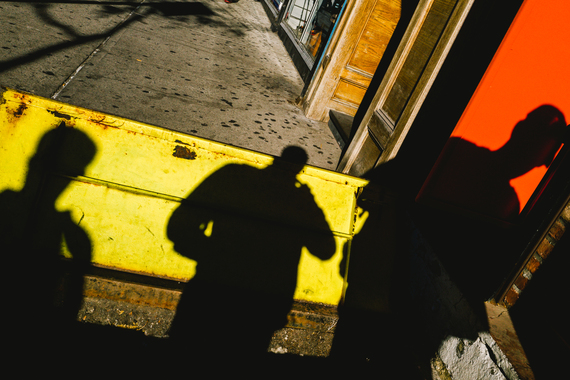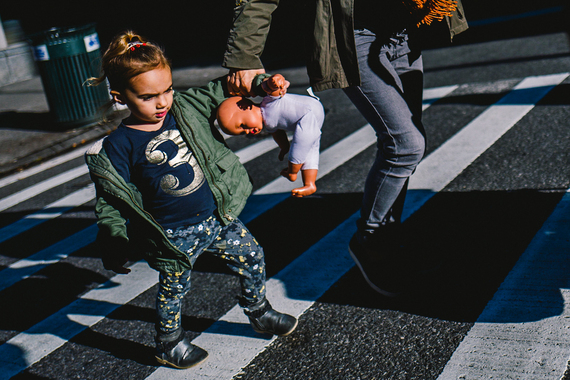For some time now I have been an admirer of Jonathan Higbee's photography. It's calm and very zen, especially for street. And, as a good friend of Jonathan's, I know he himself is not very, well, zen all the time. This ability to portray the quiet with a restless mind is intriguing. I think Jonathan's work is more traditionally "street" than much of the noise we see today with this label. This aside, his work still attracts criticism. People claim it's staged, for example. Some of his most ardent attackers (trolls) have even been very thinly separated from some big names in street photography. A ticking time bomb for one such personality. Anyhow, I told him this was a good thing - no one talks about people who are irrelevant. But Jonathan should have an opportunity to respond, also. So here we are, in conversation with New York photographer, Jonathan Higbee.
Michael: Jonathan, this photo, which you took in Times Square this summer, has generated a lot of chatter about whether or not it was staged. This, despite the fact that you have repeatedly stated that it is not a staged photo. Why do you think people have such a difficult time accepting this fact?
Jonathan: Well, it looks different than a lot of the street photography that inundates people's photography feeds these days. It's not the kind of front-on street portrait in the style of Bruce Gilden that has become synonymous with street photography in the smartphone era; it is obviously an extraordinary scene, so it's difficult for some to understand that this unimaginable moment really -- serendipitously -- and organically unfolded before me.
Although I think art should be free of rules, some people have a hard time accepting my photo because they're determined to enforce "rules" of street photography. One of the cardinal sins, according to them, is to stage a photo. That street is "not supposed to be" posed or directed. It's "supposed to be" an authentic documentation of reality. My shot plays with reality, so it's an easy target for folks concerned with this kind of regulation. I'm thrilled that I've made such a controversial image that gets people talking. The fact that some people swear it's staged is a compliment, really.
But, ultimately, what difference does it make if a photo is posed or candid? Isn't the final product -- the picture, the story, the feeling it provokes -- all that matters? Do people reject songs that aren't inspired by reality but instead imagined by the songwriter? I'm not talking about documentary photography or reportage -- that obviously, by definition, shouldn't be staged. But street?
Can you go on record here, now, exclusive to Huff Post, and tell us exactly how this photo unfolded?
I noticed the bold building-size ad for Google Play during a late-summer photowalk through Times Square. I parked in front of it for 10 minutes the first day, treating a minimalistic portion of the giant ad and the sidewalk in front of it like my own private studio. I photographed anything interesting that entered my "set" that first day, but was ultimately unsatisfied. I kept going back to the wall, waiting for up to half an hour at a time for ideal "actors" to flesh out the story. Finally, I think it was day four of waiting it out, this guy about my age decided to stand in front of the wall. He was so engaged taking his own photos of the scene behind me (one of the busiest intersections in Times Square) that he didn't notice that I was running around him like a maniac lining up my shot before he decided to move again. I worked the scene and the moment for as long as I could before he walked away. I think we were both satisfied with the photographs we got.
This idea of scoping out a scene and then waiting, like a hunter with his prey, is nothing new for you. I've been in the streets with you, many times, and this is, generally, your preferred approach to street photography. Do you feel that your work is somehow less genuine than that of your colleagues for working in this somewhat unorthodox way?
My method is no different than the typical approach to shooting street, really. Some shoot a scene for five seconds, while I might shoot it a little longer. Life is happening on the other side of the lens all the same.
Some well-known photographers have worked this way. Siegfried Hansen, for example, obviously aligns his frames in this fashion. Even Henri Cartier-Bresson, the legend himself, worked this way a lot of the time while in search of his "decisive moment". I mean, do people really think that damn bicycle was just there at the very moment HCB crested those steps? Really? Does this acceptance of the master's work in this vein, but not your own, cause any frustration?
Well, I'm an emerging artist. I still have to prove myself and earn my work's acceptance, like any artist. It's hard to imagine, but HCB existed in a time when a lot of the world still didn't accept photography as art. His career helped change that, but I understand that he was frustrated while fighting for the acceptance. For me, it can be frustrating to feel something I've poured my soul into experiencing some friction, but it pushes me to work harder and prove the critics wrong, which I'm appreciative for.
In these next two photos, it also looks like you would be subject to similar criticism. How did these photos unfold? How long did you have to wait for those men to come along in an almost "run" to match the background? Also, I can't even imagine how you managed to align that guy's stripes with the lines on the crosswalk, trade secret?
Because I always have some kind of camera with me, my mind is either consciously or subconsciously continuously scanning for a story, or at the very least, a confluence of pattern or color. The piece with the guys running alongside the ad happened within a minute of noticing the ad itself. It was rush hour in the Times Square station, and I simply anticipated this exact scene unfolding at some point -- just didn't think it'd happen so fast. It was one of those rare moments when I could actually visualize what the finished product would look like before it naturally happened for me to photograph.
In contrast, the crosswalk shot is one of those street photographs that is more luck than skill or precognition. Almost immediately after emerging above ground from Penn Station I saw a man walking toward me with a shirt that echoed the gorgeous, almost abstract arrangement of crosswalk stripes between us. I was almost half block away, so I ran toward him -- probably freaking everyone including the subject out -- and thought quickly and carefully about the angle and settings to get the shot that I wanted. I made it just in time. Thankfully I had my running shoes on.
In this next grouping, your other talent readily emerges - that of "seeing" and capturing color and form. This is almost "not street" (laughing), but rather more urban abstract. Do you feel as though your work may evolve beyond this artificially (and often ill-defined) category of street photography? Would you like to get free of it, or do you find the label is useful?
Urban abstract might be my favorite niche, so I'm proud to be producing work that may qualify. It's difficult in a chaotic, gray city like New York to discover these zen-like ambiguous stories, so it's rewarding when it all works out and I come away with work like this. Though "labels in art" is an oxymoron, "urban abstract" shouldn't be, and I hope to continue exploring it.
Gray indeed, a black and white city, as Woody Allen calls it! Finally, in these last two images we see more traditional street. Yet, at the same time, I really do see your signature here also. Artistic or photographic style is a notoriously difficult thing to develop. Your photographs need to become visually distinct as your own, and yet, at the same time, avoid being repetitive or overly-familiar. How would you describe your emerging style? What are you driving at, exactly?
As I mentioned before, modern street photography is crowded with variations on the street portrait. Some shots are very good, most are not. There's so much noise in street photography these days that one begins to crave a signal. I strive to join a few others who are making names for themselves and becoming the signal; I'm deliberately attempting to produce work that feels poetic, that feels considered and complex or layered. I'm the first to admit that I still have work to do to fully realize this, but I think I'm on the right track.
In this image, the old man sunning himself in Bryant Park, the color is so vibrant and the image so crisp and lifelike, it's truly amazing, in technical terms. What camera were you using here? What gear do you use, in general, these days?
This scene from Bryant Park was made with a Sony A7R and Zeiss 55 1.8 (a dream combo). My most popular work so far has been shot with the A7R, which might be my favorite camera, but I was recently given the Leica Q and have started to produce some great stuff with that, too. For my 35mm work, I use a Leica M6 and a stealth Konica mini AF. Unlike cameras, there's only one film I'll use: Fujifilm Velvia. There's no comparison if you're into rich and vibrant tones. Finally, my iPhone 6 Plus camera gets some mileage too, and is an unbelievable camera to be carrying around in a pocket.
The image of the child with the doll, which I dearly love, is a great photograph. I was with you the day you made this one. I remember the moment you captured it. The capture was very graceful, unobtrusive, and almost inconceivable - given that you were using a 28mm and shot across me and several other people and still got a clean tight frame. Do you think this more graceful and less garish and flagrant approach to street capture is your secret? How do you feel about Gilden and the many, many, copies who work in his style?
Well, I do think that the mindset required to shoot "gracefully" -- as you say -- and unobtrusively can influence the images I walk away with. So, since I'm establishing my style as zen-like street, this particular process of "respectful" shooting allows me to realize the kind of poetic street photography I want to make.
But you must have only been with me on good days. There are many, many photowalks I experience that don't go so well. I'm often as messy as my anxious mind and inelegant in my method, which leads to chaotic, busy images that don't always work well. Many other street photographers make this style of shooting and photography work for them, though, and I respect it since I find it so foreign and difficult myself.
If you could snap your fingers and change one thing, overnight, in the street photography community, what would it be?
Easy. I'd snap my fingers and get rid of the politics associated with street photography. I'm still new to the community, but have already encountered extreme politicking and ego. Maybe it's because the barriers to entry for the genre are so low (no lighting rigs, studio, makeup, etc. required), making street the most competitive niche in photography (and perhaps all of modern art). I was initially attracted to shooting street because of the pure exhilaration and fun of the entire process, from shooting to editing and sharing work, and I wish it was easier for us all to remember (myself included) what brought us here in the first place. On the other hand, I don't see enough respectful constructive critiquing occurring. It sometimes feels like an echo chamber, with many photographers unable to improve their work or style because audiences and commenters are afraid that anything other than "this is amazing!!!!!" will offend. I'd like to substitute the politics with respect and constructive criticism. In other words, I wish the community worked more to lift each other up than tear each other down.
Yes, I hear you. It really is sad how much politics dominates a field of photography that generates virtually no income (laughing). And you are bang on about the lack of criticism, as I wrote about here (and received the kind of reaction of which you speak). That said, let's end on a more positive note. I hear a couple of really great moments are coming your way, in terms of your photography career, so all eyes are on you, Sir. Many people admire your work (and those of us who know you personally, admirer you, the man behind the lens, even more) and that's perhaps the biggest compliment you'll get in this game.
Jonathan Higbee is a New Yorker by way of the Midwest and West Coast. He's a storyteller, a loving husband, a human companion to the most heart-warming dog in all of existence and a full-time editor for a national magazine. Follow Jonathan on Instagram or through his website.
Michael Ernest Sweet is a Canadian writer and photographer based out of New York City. He is the author of two street photography monographs, The Human Fragment and Michael Sweet's Coney Island, both from Brooklyn Arts Press.
